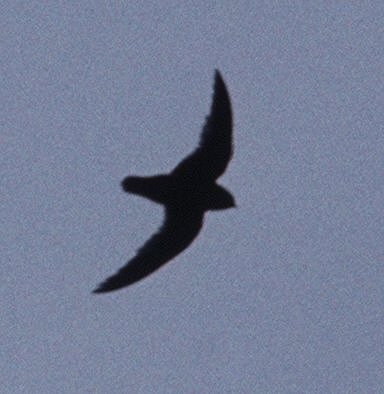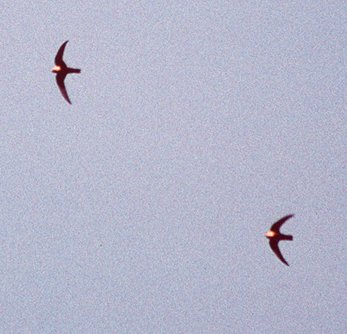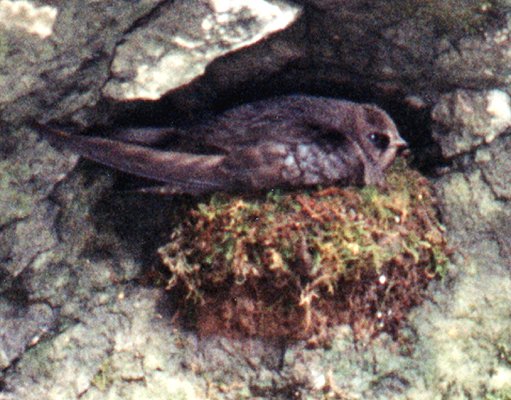|
Black Swift Cypseloides niger Vencejo Negro
|
 |
|
Photo: D. Paulson
|
|
Black Swift Cypseloides niger Vencejo Negro
|
 |
|
Photo: D. Paulson
|
|
IDENTIFICATION: An all-black bird that flies to great heights in search of insects. It has a slender body with thin, tapered wings, and a long, slightly forked tail---although the fork may be absent in some females. Juveniles have white edges to the feathers on the undersides. Length: 18 cm.; weight: 36 g. VOICE: The call is a fast "chi-chi-chi-chi." Usually silent away from nesting sites. HABITAT: Forages mostly high over mountain forests, but may descend lower over coasts and wetlands, far from the nesting area if forced down by low cloud cover. HABITS: The Black Swift captures flying insects and floating spiders high in the air. It often glides with its wings pointed slightly downward. The swift may flock with others of its kind or join mixed flocks with swallows. Although it catches insects like a swallow, it is actually more closely related to hummingbirds---an example of convergent evolution. The swift has elaborate, aerial courtship rituals, and will copulate in the air. The nest is made of moss, ferns and rootlets, bound with mud, and is placed on a narrow ledge on a cliff, often near a waterfall. Although it cannot walk well, its tiny claws are very strong---an adaptation for clinging to rock surfaces while nest building. Little is known about the biology and even the measurements of this species in Puerto Rico. But in most of its range, the female lays one egg, which both sexes incubate for 24-27 days. Both sexes feed the chick for 45-49 days before the chick fledges. STATUS AND CONSERVATION: An uncommon, local species in Puerto Rico, and is difficult to see because it often forages high in the air. It disappears from the island in winter. Satellite transmitters are becoming tiny enough for tracking small birds, so it may eventually be possible to track the Black Swift and other small migrant species, and identify winter grounds for specific populations. This would be a key step in protecting species in important breeding and wintering areas. RANGE: Breeds in scattered mountain areas from southeastern Alaska south to Costa Rica. In the Caribbean it is presumed to breed in the Greater Antilles and from St. Kitts south to St. Vincent. The North American population migrates south to Central America for the winter. Swifts from Puerto Rico and the Eastern Caribbean may winter in South America, but the location of the winter grounds is still a mystery, as is much of their biology. Regular over El Yunque and Maricao State Forest. TAXONOMY: APODIFORMES; APODIDAE; Cypseloidinae |
 |
|
Photo: G. Beaton
|
 |
|
Photo: E. McClintock
|
|
References Arendt, W.J. 1992. Status of North American migrant landbirds in the Caribbean region: a summary. Pp. 143-171 in Ecology and conservation of neotropical migrant landbirds (J.M. Hagan III and D.W. Johnston, eds.) Smithsonian Instit. Press, Washington, D.C. Bent, A.C. 1940. Life histories of North American cuckoos, goatsuckers, hummingbirds and their allies. Smithsonian Instit. U.S. National Museum Bull. 176. (Reprinted by Dover Press, NY, 1964). Chantler, P. and G. Driessens. 2000. Swifts: a guide to swifts and treeswifts of the world, 2nd edition. Yale Univ. Press. del Hoyo, J., A. Elliott, and J. Sargatal, eds. 1999. Handbook of the Birds of the World, Vol. 5. Barn Owls to Hummingbirds. Lynx Edicions, Barcelona. Ehrlich, P.R., D.S. Dobkin, and D. Wheye. 1988. The birderís handbook: a field guide to the natural history of North American birds. Simon and Schuster / Fireside, NY Holmgren, J. 1998. A parsimonious phylogenetic tree for the swifts, Apodidae, compared with DNA-analysis phylogenies. Bull. B.O.C. 118(4):238-249. Kepler, C.B. 1972. Notes on the ecology of Puerto Rican swifts, including the first record of the White-collared Swift (Streptoprocne zonaris). Ibis 114:541-543. Lowther, P. E. and C. T. Collins. 2002. Black Swift (Cypseloides niger). In The Birds of North America, No. 676 (A. Poole and F. Gill, eds.). The Birds of North America, Inc., Philadelphia, PA. Raffaele, H.A. 1989. A guide to the birds of Puerto Rico and the Virgin Islands. Princeton. Raffaele, H.A. 1989. Una guía a las aves de Puerto Rico y las Islas Vírgenes. Publishing Resources, Inc., Santurce, PR. Raffaele, H.A., J.W. Wiley, O.H. Garrido, A.R. Keith, and J.I. Raffaele. 1998. Guide to the birds of the West Indies. Princeton. Next related species in taxonomic order Previous related species in taxonomic order |